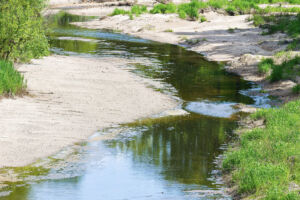Regional groundwater stress is made visible by comparing average groundwater recharge and human water abstraction. In order to be able to capture sector-specific and supraregional influences on regional groundwater stress, extended usage data such as public and non-public water abstraction are differentiated and, for example, long-distance water infrastructure is included. The aim is to identify structural and acute overuse of groundwater in Germany and to outline possible causes. The work thus supports the sustainable management of groundwater bodies.
Research approach
The research team evaluates the scientific literature on the methodological assessment of groundwater stress at the regional level. Taking into account the available data on average groundwater recharge, groundwater level trends, and groundwater abstraction at the county level, existing approaches are conceptually expanded. Particular attention is paid to differentiating water withdrawals from groundwater by sector (public water supply, manufacturing, agriculture) and to including supraregional transfers of groundwater to other districts. To this end, the research team is drawing on its own work on long-distance water infrastructure in Germany and analyses of groundwater stress in Europe. The compiled data sets will be transferred to a database structure. Finally, districts and district-free cities will be identified by highlighting structural overuse and taking into account falling trends in groundwater levels. The results will then be displayed in diverse maps.
Background
In Germany, the prolonged drought from 2018 to 2022 has led to falling groundwater levels in some regions and thus to problems in the water supply. In addition, water stress and the subsequent pest infestation damaged numerous ecosystems, such as forest areas in the Harz and Taunus mountains. Added to this are rising peak demands from the population on hot and dry summer days, as well as new demands on groundwater resources due to irrigation needs in agriculture and withdrawal requests from commercial enterprises. Against this backdrop, the German Federation for the Environment and Nature Conservation (BUND e.V.) commissioned ISOE to conduct an indicator-based assessment of groundwater stress with the aim of identifying hotspot regions in Germany and gaining a better understanding of potential causes ofoverexploitation.
Client
The project to develop the indicator for regional groundwater stress was commissioned by the German Federation for the Environment and Nature Conservation (BUND e.V.).
Contact:


